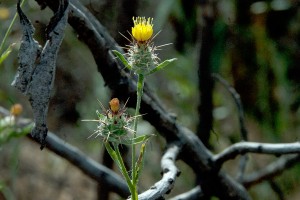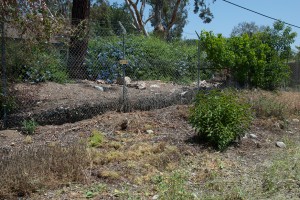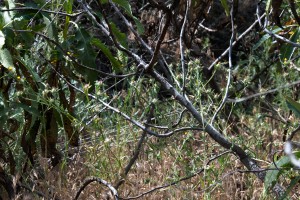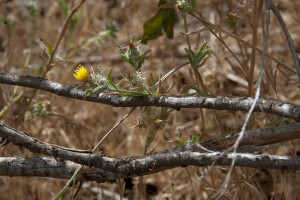A long time ago in a galaxy far, far away…. Oops! Wrong STAR WARS.
Right now, in this very galaxy, on this very planet, right here at the Bernard Field Station, the valiant BFFs of the BFS battle are battling alien invaders in the STAR-thistle WARS.
The alien invader is the Maltese Star-Thistle (Centaurea melitensis) also known as Tocalote. This native of the Mediterranean region of Europe and northern Africa arrived in California during the Spanish Mission period, and its seed has been found in adobe bricks of a building constructed in 1797.
Dense stands of Maltese Star-Thistle can displace native plants and can cause native species to experience drought conditions even in years with normal rainfall. Maltese Star-Thistle is poisonous to horses, and the spiky flower heads can mechanically damage wildlife.
Although the plant has been in Southern California a long time, it has recently become much more of a in our area, where it is currently widespread and increasing. At the BFS it seems to be moving out of disturbed areas and into openings in the coastal sage scrub. A single plant typically produces about 1500 seeds, and while most of the seeds fall near the parent plant, some are spread along trails and roads by sticking to people and animals.
Our strategy at the BFS is three-pronged:
- Removing all thistles from sites of new infestations
- Mowing large infested areas to reduce seed production
- Removing thistles by hand on the edges of the mowed areas, especially where they have moved into the coastal sage scrub.
On May 19, we fought our first skirmish, when volunteers removed a small localized infestation just west and south of the Lowell Avenue gate.
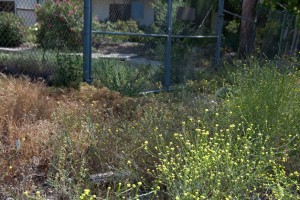
Centaurea melitensis (center) between Bromus and mustard in front of the Lowell Ave gate. ©Nancy Hamlett.
The Maltese Star-Thistles in this area are mixed with exotic mustards, Bromus, Euphorbia, and Horehound, but some natives are also present, and we hope removing the weeds will facilitate their growth, so we also removed mustards.
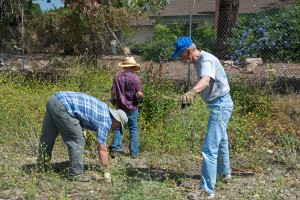
Paul Stapp, Ben Stapp, and Dick Haskell pull C. melitensis next to the Lowell Avenue gate. ©Nancy Hamlett.
On May 18, we mounted a second offensive as a professional crew from Johnny’s Tree Service weed-whacked a major portion of largest infestation in the grassy area west of the entry drive.
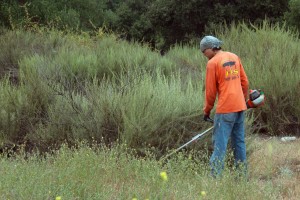
A worker from Johnny's Tree Service weed-whacks C. melitensis west of the entry drive. ©Nancy Hamlett.
On May 26, volunteers followed up in this area, pulling by hand the star-thistles among and under shrubs where the weed-whackers couldn’t reach at the margins of the mowed area.
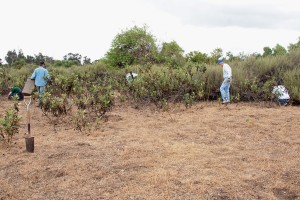
The volunteers attack the margin of the mowed area. Left to right: Anne Clark (HMC ’13), Tim Cox, Mike Tschudi, Dick Haskell, and Bryan Visser (HMC ’13). ©Nancy Hamlett.
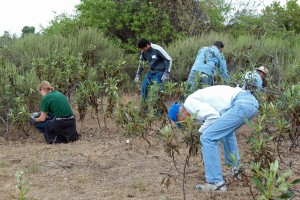
The volunteers at work. Left to right: Anne Clark (HMC ’13), Somaiah Kambiranda (CMC ’15), Mike Tschudi, and Dick Haskell. ©Nancy Hamlett.
Literally thousands of thistles were uprooted in the morning’s work! Here the conquering heroes pose with a pile of the vanquished foes (together with the odd mustard we couldn’t resist pulling);
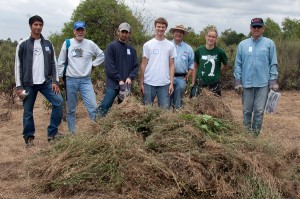
The volunteers with their haul of C. melitensis. Left to right: Somaiah Kambiranda (CMC ’15), Dick Haskell, Elliott Cox, Bryan Visser (HMC ’13), Mike Tschudi, Anne Clarke (HMC ’13), and Tim Cox. ©Nancy Hamlett.
We will probably have one more volunteer day devoted to Maltese Star-Thistles on June 2. Please join us if you can! We can use all the hands we can get! If you’re interested, or you have any other questions, please contact Nancy Hamlett, BFS Volunteer Coordinator, at nancy_hamlett@hmc.edu.
References and further reading:
- TexasInvasives.org (2008) Centaurea melitensis, Invasives Database. http://www.texasinvasives.org/plant_database/detail.php?symbol=CEME2
- California Invasive Plant Council (Accessed 2012) Centaurea melitensis (Malta starthistle, tocalote). Plant profiles. http://www.cal-ipc.org/ip/management/plant_profiles/Centaurea_melitensis.php
